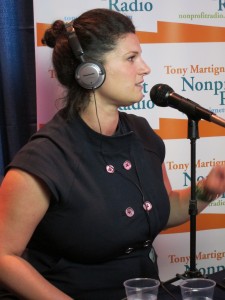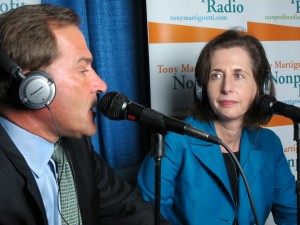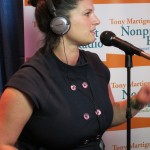
Stacy Palmer: The Chronicle of Philanthropy Will Go Nonprofit

The Chronicle is taking a bold step, from privately held to nonprofit. Why? What does that mean for journalism that covers our community locally and nationally? What can you expect for webinars and professional development? Editor Stacy Palmer answers all the questions.
Listen to the podcast
Podcast: Play in new window | Download
Get Nonprofit Radio insider alerts!I love our sponsors!
![]() Turn Two Communications: PR and content for nonprofits. Your story is our mission.
Turn Two Communications: PR and content for nonprofits. Your story is our mission.
Fourth Dimension Technologies: IT Infra In a Box. The Affordable Tech Solution for Nonprofits.
We’re the #1 Podcast for Nonprofits, With 13,000+ Weekly Listeners
Board relations. Fundraising. Volunteer management. Prospect research. Legal compliance. Accounting. Finance. Investments. Donor relations. Public relations. Marketing. Technology. Social media.
Every nonprofit struggles with these issues. Big nonprofits hire experts. The other 95% listen to Tony Martignetti Nonprofit Radio. Trusted experts and leading thinkers join me each week to tackle the tough issues. If you have big dreams but a small budget, you have a home at Tony Martignetti Nonprofit Radio.
View Full Transcript
Processed on: 2022-06-23T13:04:40.019Z
S3 bucket containing transcription results: transcript.results
Link to bucket: s3.console.aws.amazon.com/s3/buckets/transcript.results
Path to JSON: 2022…06…597_tony_martignetti_nonprofit_radio_20220627.mp3.893170859.json
Path to text: transcripts/2022/06/597_tony_martignetti_nonprofit_radio_20220627.txt
Hello and welcome to Tony-Martignetti non profit radio big non profit ideas for the other 95%. I’m your aptly named host of your favorite abdominal podcast. Oh, I’m glad you’re with me. I’d bear the pain of borelli assis if you infected me with the idea that you missed this week’s show, the Chronicle of philanthropy will go non profit The Chronicle is taking a bold step from privately held to non profit why what does that mean for journalism that covers our community locally and nationally? What can you expect for webinars and professional development editor, Stacy palmer answers all the questions. non tony steak too. This is show # 597. We’re sponsored by turn to communications pr and content for nonprofits. Your story is their mission turn hyphen two dot c o And by 4th dimension Technologies IT in for in a box. The affordable tech solution for nonprofits. tony-dot-M.A.-slash-Pursuant D Just like three D but they go one dimension deeper here is the Chronicle of philanthropy will go non profit it’s my pleasure to welcome back Stacy palmer to non profit radio she is editor at the Chronicle of philanthropy. She’s been editor since the chronicle’s founding in 1988. Stacey welcome back to nonprofit radio [00:01:49.19] spk_1:
delighted to be with you again it’s [00:02:21.34] spk_0:
a real pleasure thank you, Thank you um and I want to Disclose to listeners that I was a podcast publisher For the chronicle of philanthropy for about four years I published their fundraising fundamentals podcast. So Stacy early May you, you had a little announcement, a little, a little thing. You leaked something out about the Chronicle going non profit So what’s this? What’s this little bit of news about? [00:03:34.74] spk_1:
Thank you for asking about that. So we’re very excited about the fact that we’ve been working on a growth plan. Um, and one of the things that we realized we wanted to do more of is to influence how nonprofits are covered by the mainstream media. And so we are doubling down on a lot of the work we do to help nonprofit professionals, but also expanding our mission to do even more to make sure that other journalists are paying attention to nonprofits and foundations and giving them really the attention that they deserve. Um, so our mission is growing and our staff is growing. Um, and as a result of that, we decided that it was time for us to move out of the organization that now houses us, which is the Chronicle of Higher Education. We’re going to go independent and part of going independent is deciding that a non profit structure makes more sense that way. We’ll be in tune with what our readers are experiencing and doing every day. Um, and so, you know, it was sort of two separate decisions, how do we grow and what status do we want to have? Um, and we examined it pretty closely and decided nonprofit status was right for us. So now we have the I. R. S examining our requests to become a charity. So we are not officially that yet. We are in that waiting period. [00:03:47.34] spk_0:
All right. You’re not just gonna be attuned to what nonprofits are going through day to day. You’re going to be enjoying it, enjoying it and suffering it with them. So there’s gonna come a day when there’s gonna be a donate now button on the Chronicle of philanthropy website. [00:03:58.94] spk_1:
We haven’t decided what we’re doing about that piece of it, but money from foundations, mostly [00:04:17.04] spk_0:
foundation. Okay, sure. Um, and you are going to be executive director of the new the new non profit Okay. How does that coincide with being editor of the Chronicle? [00:04:21.91] spk_1:
So we’ll be hiring an editor to take my place. Um and obviously I’ll be working really closely with that person. Um, but we need to make sure that we have somebody else who is day to day thinking about our coverage. Um, so that I can do all of the things that the nonprofit needs to make sure we run well and do things and you know, develop these other partnerships. So I’ll be doing a lot of other things other than editing every day. [00:04:49.24] spk_0:
Interesting. So that’s a huge transition for you. [00:04:51.72] spk_1:
It is, it is [00:04:52.66] spk_0:
gonna be you’re gonna be a nonprofit executive director [00:04:58.84] spk_1:
Exactly. Learning how to do it. And one of the things I realized given the nature of our coverage. While we do a lot of advice. We also cover a lot of the ways in which things go wrong with boards and executive directors and those kinds of things. And so now I’m really putting my attention on what makes things go right. Um and realizing I need to learn a lot more about that, [00:05:39.64] spk_0:
I see a stack of books that books about nonprofit management. No, I don’t know. All right, okay. So you’re you’re committed to increasing collaborations, increasing staff. You know, I think listeners are very interested in what this significant transition means for them as as readers as consumers of your content. So what what do you see around these collaborations? The staff increases? [00:07:53.94] spk_1:
Yeah, I would say for nonprofit professionals, there are several things that are important about what we’ll be able to do. Um one is that we know we need to provide more tailored information depending on what job you have what size your organization is. And we have been doing a fair amount of research. Um some of it got interrupted by the pandemic to better understand what our audience needs and especially as the field is changing. Um so one of the things we want to do is provide much more tailored information. So, you know, newsletters that are geared to the kind of job kind of organization. Um making it easier on our website to find things our webinars, you know, that you can decide whether you need an advanced level webinar or beginner level webinar. We have people at all stages um and their organizations of all sizes. We, you know, provide information to one person organizations and to organizations that are as big as Harvard the nature Conservancy, those kinds of organizations. So we need to serve everybody according to their own needs. So our growth is going to be geared at, you know, making sure that when you have a need, you can turn to the Chronicle of philanthropy and we will be better able to serve you rather than right now. We’re a bit of a one size fits all kind of publication and we know that needs to change. The other thing we’re really looking at is how do we make sure that we reach the next generation of nonprofit professionals, a lot of people who have grown up with the Chronicle um we deeply appreciate, but we know we need to expand out to all the people who are coming into the field. That probably means more video, more audio podcast. Yea, um that will go back into doing things. So as we step up, we plan on expanding the skills that we have in the range of ways that we can reach people. One of the things that have just been enormously popular, especially during the pandemic are our live briefings um that are freely available, gathering experts to talk about really important topics. Um and we’ve been just delighted by the response to those. It’s a very easy way for people in one hour to get a lot they know on a specific topic. So we’ll probably expand those kinds of things too. So people shouldn’t think of us as just this old fashioned print publication. We’re not that anymore, but we’re going to be even less of that, I would say in the days to come. [00:08:13.04] spk_0:
So you see greater investment opportunities than then you saw as a part of being owned by the Chronicle of Higher Education. Yeah, [00:08:55.74] spk_1:
I mean part of it was just the capabilities that we had with it being within that organization were 1/6 the size of the Chronicle of Higher Education. So that just meant that we couldn’t grow as much as we wanted to. Um, but the, this is a very friendly separation, the Chronicle of higher Education, I knew that we needed to grow and basically encourage this because it was the only way that we would be able to serve our audience well. And one of the things we found, you know, a lot of our readers are in higher education and that’s it’s so natural that the Chronicle of higher Education spawned the Chronicle of philanthropy, but colleges and universities are now very different than not many nonprofits. And so the things that we used to have in common about serving our audiences, we don’t find those with the case as much and sometimes they’re so different that, you know, if we do something that the Chronicle of Higher Education does and we try it with our audience that just falls flat and vice versa. So that’s one of the reasons we decided that it’s better for us to go independent. [00:09:41.24] spk_0:
You know, I’ve been seeing for years the decline in, in non profit coverage. So I, you know, I remember when Stephanie strom had been non profit beat the new york times and I think it was Melanie West had donor of the day in, in the, in the in the Wall Street Journal. I mean there were, there were, there were non profit beat reporters and I don’t know of one now any anymore. [00:10:01.84] spk_1:
Well now there is, this is interesting actually. I mean the Times has David Fahrenthold who’s covering non profit fraud and you have nick Kulish who is covering billionaire philanthropy and those are the two areas that the Times has said is what it needs to cover and that’s the vote on the things that matter most. So [00:10:09.35] spk_0:
did [00:10:09.82] spk_1:
not know that when you know, we decided to go ahead, we started our planning long before those appointments were put in place, but I feel like that’s a call to action of all the other things that news outlets need to cover and especially one of the things we’re very excited about is working with all of these non profit news organizations that are sprouting up to cover either specific communities or look at specific issues, the marshall project, you know, looks at criminal justice for example, talk looks at education. Um, there are all of these nonprofits, you know, that are just starting to figure out what their coverage areas are and we want to make sure that they embed coverage of non profits as part of what they do all day. So that’s where we’ll be working most closely [00:10:56.53] spk_0:
interesting. So you mentioned, even on the local level, [00:10:59.14] spk_1:
yes, definitely. [00:11:00.36] spk_0:
Much more local than like propublica or Center for investigative journalism. [00:12:51.64] spk_1:
And you know, propublica has done a lot to go local as well. And so we’re following what they’re doing in terms of some of that, but you know, philanthropy is so local. Um, and that’s what people really need to understand these things. Um, and so that’s why we, we would like to work there. Um, you know, we will work nationally to. Um, but one of the things that we started last year um, is a fellowship program for local journalists. And so we have four fellows that are working on various projects. We’re teaching them how to cover philanthropy in their communities. So there’s a nonprofit news organization in Boulder that’s looking at all the money that came in after the Wildfires there to the Community Foundation and asking questions like how do, who decides how that gets spent? Where does it go? How do they raise money? What do they do? And it’s an unprecedented sum for that Community Foundation to have that flowed in because it was the nature of the disaster was so intense. But we were really excited that they had a pitch where they actually knew what community foundations were, they wanted to explain. You know, that this is how it works, um, and investigate that sort of thing. So we hope that assuming, you know, these fellowships go, well, we’re in the early stages of it, but then we’ll do a lot more of that where we work intensively with local organizations today in journalism. There are a lot of these one off seminars on nonprofits. Some of your listeners may have been asked to speak at those things where, you know, an hour on what makes nonprofits important or something like that. Well, that doesn’t have a really long lasting effect in changing the coverage. Um, and we’re hopeful that by spending an entire year with these news outlets that that will make them decide this is important and this kind of coverage needs to continue and we hope that it will be more sophisticated coverage than we’ve all been used to seeing. I think, you know, I know the number of nonprofits that send me notes every once in a while, say, can you believe this news organization set X or y or Z. And they clearly don’t understand how nonprofits work. And so we want to do something to change that. [00:13:09.14] spk_0:
Alright. I’m still bothered by the fact that the new york times hyphenates. We [00:13:12.50] spk_1:
we follow New york times style. So I get the angry letters about their style all the [00:16:52.04] spk_0:
time. It’s time for a break. The only one of the show turn to communications have you got your crisis communications plan in place so that you know who’s responsible for message creation. Is it the one person or is it a couple of folks a committee who needs to approve that messaging who’s authorized to speak on behalf of your non profit who’s gonna brief internally and who’s going to brief external audiences. There’s more to a crisis communications plan than that. Turn to knows what all belongs in there and they can help you create yours so that you’re ready. When the crisis comes. Turn to communications turn hyphen two dot C. O. Fourth dimension technologies. Their I. T. Solution is I. T. Infra in a box. It’s budget friendly. It’s holistic. You pick what you need and you leave the rest behind. That makes it your I. T. Buffet but why is this a budget friendly buffet because you pick only what you can afford from the buffet selections, your budget can’t afford shrimp and lobster, have the tuna salad, no rack of lamb just get the mint jelly, choose what’s right for your I. T. Situation and your budget. Fourth dimension technologies. tony-dot-M.A.-slash-Pursuant D. Just like three D. But they go one dimension deeper. It’s time for Tony’s take two. This is show # 597 woo. But don’t celebrate because the big celebration is coming in. Just a few weeks, three weeks to be exact because that’s when The 600th show is Coming out on July 18 of course we’ve got the live music coming from Scott Stein, you gotta have that with the live playing of cheap red wine and a couple of other songs that he will do for us, naturally the co host for every milestone show, Claire Meyerhoff, she will be with me, we’ve got our esteemed contributors, Amy sample Ward and Gene Takagi, they’ll be with us as well. The sponsors are coming sponsors turn to communications four D technology, they’re all going to be with us. So it’s the blowout show coming in just a couple of weeks, three weeks to be exact, the 6/100 it’s on its way. That is Tony’s take two, we’ve got boo koo but loads more time for the Chronicle of philanthropy will go non profit with Stacy Palmer, we’ve got the boo koo because I grouped the sponsored messages and the tony state two together. You see how it’s all structured for your benefit so we can do the boo koo. It’s it’s hard, I feel bad when it’s just a just just a butt load when you’ve got the boo koo but loads then you know your set, I mean, I mean that’s the ship when you got the boo koo. So that’s where we are, you, you you’re doing something now with the so thinking nationally now with Associated Press their partnership with them. What’s that [00:17:01.94] spk_1:
about? So the lilly endowment made a very generous grant to our organization, Associated Press and a group called the conversation, which does terrific work to get um scholarly articles out to the public in very accessible ways. So we’re all working together to put the spotlight on philanthropy. So the Associated Press hired to reporters um who are now covering philanthropy, we’ve hired three reporters who, and so as part of a collaboration, we worked together um, to provide more coverage is aimed at the general public. You know, a lot of these stories appear for our readers, but you know, when we when those reporters are looking at it, they’re saying what’s of interest to local news organizations, what’s gonna cause um a local outlet to republish this kind of thing. And really the Associated Press obviously is global. Um, so what’s of interest to them. So the fact that we have now added five reporters focused on helping the general public understand it’s just enormous. I mean, what we were just talking about before is how the coverage has dropped so much. Um and the fact that now we have people paying attention to this all the time. It’s just fabulous. Our articles appear on the Associated Press feed. We published some of the Associated Press articles and we were working on some ambitious projects together. One area that we’re looking in, especially right now is gun violence and we started this, you know, long before Vivaldi and Buffalo, um, to put the spotlight on what philanthropy and what nonprofits are doing to curb gun violence. And so you’ll see a lot of stories going in depth on that topic over the next year. [00:18:41.64] spk_0:
You, you promised to build a public commons for debate. How can people, what does that look like? [00:20:02.54] spk_1:
I would love to hear from listeners, um, what they would like to see that we’re in the earliest stages of developing that. But I would say, you know, as, especially when I talked to funders, the thing that bothers them most and that they’re working on and that they want to solve. And they would like us to be a part of it is bringing together the polarized sides in philanthropy itself. I mean obviously they’re working to bridge the divides in the country. Um, but philanthropy has a lot of challenges talking to itself, um, lifting up voices that often aren’t heard. Um, conservatives often feel that their ideas are run over by progressive philanthropy. Um, you know, there’s great concern that there’s not enough attention to rural voices to people of color to younger voices. There are just so many challenges of getting people to express their views to hear each other to do well reasoned essays to debate each other. Um, and to figure out where they have common bonds, which they have a lot more of than they realize, but our work is going to be to help people overcome that. Um, and also, you know, we plan to cover that area to what are the non profits and foundation efforts that are successfully bridging divides. So they’ll be, you know, a multipronged effort on that. But we really would love to hear from as many people as possible about what, what gaps they see that we can feel. We don’t want to duplicate what other people are doing. Um, you know, we should be additive. So whatever we can do on that front, we’d love to do. [00:20:24.04] spk_0:
Gosh, I I hear a lot of opportunities for podcast since you mentioned it. That’s that, that’s, that’s a rich one I think. [00:20:31.32] spk_1:
Yeah, absolutely is more [00:20:34.09] spk_0:
live events. You, you anticipate more those, you, you they’ve been well reviewed. Your, I know your webinars do well. [00:22:17.24] spk_1:
Our webinars, our, you know, our webinars are geared at professional development and very, very well attended. Um, and you know, we bring in, you know, we work hard to get experts who, you know, know what they’re talking about can give real great case studies and examples and help, you know, help people understand what it is that they need to do in an area maybe that they’re not familiar with. Um, so those are very popular and then the live briefings are a little bit different. Um, in that there will be a topic, you know, one of the ones we’ve got coming up, um focuses on a new report that’s come out about how to reach diverse donors. And we’ll be spotlighting some of that research, for example. So there are a lot of different opportunities. I don’t know whether we’re getting to the point where we’re gonna be able to return to in person events. We hope so at some point, um, we’ve got some inquiries from folks that want to do some things in the fall. I I just don’t know health wise whether that’s going to be a safe thing to do. Um, so we expect to be virtual for a while, but we definitely do a lot live. And this partnership that I mentioned with Associated Press in the conversation, A component of that also is live online briefings. So, you know, we’ve done a number of different topics will be getting into climate philanthropy will do something on the gun violence package I mentioned. Um, we did, you know, as soon as the Ukraine war erupted, we did something to help people think about both the short term and the long term aspects of giving because we didn’t want to have, you know, there was such a rush to give, which is wonderful, but we know in all disasters you need to think about the long term. And so we gathered some experts who could talk about why it’s smart to start thinking about that now. [00:22:33.54] spk_0:
So, you know, I’m hearing, uh coverage and professional development expansion of the the expansion of the work for the nonprofit community, but also, you know, in these partnerships and the fellowships, you know, expanding coverage about the nonprofit community to the, to the general readership. [00:24:01.84] spk_1:
Exactly. And obviously for nonprofits, that’s usually important because they aren’t getting the attention or understanding they deserve. So while you know, you can talk about those things being different, they sort of our version of the same thing is we see it as an extension of how do we better serve nonprofits? We help get their stories out. And one of the things I think the Chronicle has always been very good at doing is helping nonprofits tell their story. Um, I wish nonprofits invested more in being able to do that themselves. I hope maybe we can help them in more ambitious ways than we do now. Um, but a lot of times when Chronicle reporter contacts and nonprofit, it’s the first time that they’ve had a chance to gather the photos to get the examples to get the data and the evidence that they need to show why what they’re doing is super effective and worth other people knowing about that often then allows them to take the story to their donors, to other people to know about them. Um, and so, you know, I think the more we can do with that to help get the word out about what nonprofits are accomplishing get people engaged in that. Um, we hope that that helps, it’s another part of the democracy and divide building, you know, is that if people knew that nonprofits are solving more problems, we hope that that allows the nonprofits themselves to be more effective. [00:24:13.54] spk_0:
You’ve got some ambitious goals that you published double revenue and subscribers in five [00:24:42.34] spk_1:
years. Yeah, we expect to be able to do that in part because what will be investing in is a staff that spends all of its time thinking about those things right now, we don’t have that. Um, and so, you know, once we add more people who focus both on our business and technology, we think it will be pretty easy for us to expand our revenue. We’re very excited that we have strong foundation support, but we want to make sure that we’re earning our own way, um, and that were sustainable and have very diverse revenue sources. Um, and so that’s what we’ll be working on building like every Good non profit needs to do. [00:25:03.24] spk_0:
And then right on the heels of that comes the conversation about transparency and the separation between uh, fundraising and, and editorial. So why don’t you reassure folks? [00:26:12.94] spk_1:
Yeah, no, that’s I thank you for raising that. What’s part of what we’ll be working on really intensively over the next few months before we become a nonprofit, um, is to strengthen some of the guidelines that we have now that we use when we’re accepting gifts and disclosing right now, we’re very good about that. We receive a very small amount of foundation support right now, and we’re grateful for all of it, and we always disclose it, but we want to be more transparent about how we make decisions about stories. Some foundations have asked me questions about, like if they’re supporting us, can they still pitch stories to us? Um you know, and how do we handle that? We probably will do webinars and other sessions where readers can ask us questions about Our coverage and make sure that if they see anything that bothers them, they can let us know. Um I think, you know, we’ve had nearly 35 years of publishing in this field, I think our integrity is pretty strong, but we want to make sure that we keep it that way and that there’s no perception of any influence. And one of the things I’ve loved in the conversations I’ve had with foundations seeking their support is how conscious, they are that they no way want there to be any perception that they’re influencing our coverage. And, you know, a few foundations, if they said no to us, it was out of that concern that they think that it’s impossible to help, you know, that perception is gonna be a problem and they didn’t necessarily want to be part of that, and I really respect that. [00:26:30.49] spk_0:
Is it. Is it much different than the separation between advertising and editorial. [00:28:18.04] spk_1:
Glad you asked that No, it’s not. And we have always had to be conscious of, you know, influences, you know, a lot of our advertisers provide services to the nonprofit field or their foundations that want to, you know, talk about a specific project, you know, and they’re doing it with their advertising dollars. Um, so it’s not different. You know, the other thing people often get in a not about advertisers or foundation support if we alienate our readers are subscribed or revenue is hugely important. And the fees that webinar, you know, each person is individually paying a subscription and it may not feel like a huge amount of money, but it adds up to being a significant sum source of our support and the reason for our being so if we do anything that tarnishes that we are in trouble. So that’s who we put first is our readers, um, and thinking about their needs. And I have found that, you know, as we’ve been going into this nonprofit work, I have become much, much more aware of the challenges that nonprofits face. I mean, I knew it from our coverage, but you know, I do, I already feel living it every day. Um, I understand much better what challenges they face. And I think that will be a good thing for all of all of my, all of the audience and for all of our staff, which will get to know that more transparency is something that is very different than the private company we’ve worked for. So, you know, we’re excited about, you know, really, you know, doing our 1st 9 90 making sure that it’s clear doing annual reports, all the kinds of things that we haven’t done before. Um, but we know that we need to meet the highest bar in terms of transparency. So we’ll be looking at that and I hope others will hold us accountable for some reason we fall short, but we’re gonna try to do our best not to [00:28:23.64] spk_0:
what’s on your mind as you’re, uh, and uh, an imminent executive director. You know, what kinds of, you know, what’s keeping you awake? What are you thinking about? [00:29:27.54] spk_1:
Oh, all of the things related to the transition. Um, as you can imagine, it’s, there’s just a lot of work to make sure that we do this really well. Um, and that my staff is really excited about what we’re doing. So, you know, the next thing we’re doing, um, is, you know, really sort of outlining our values as a team because we will have this new organization that we can build. Um, right now we follow what the Chronicle of higher education does. Now we get to say what happens when we build our own culture and our own organization and how do we do that? Well? Um, so, you know, it’s pretty thrilling to be able to reinvent an organization that’s as old as ours is, we’ve got the strong backing of the Chronicle and the organization that we have, but we are reimagining almost everything and and that’s just the most thrilling thing possible. But it is scary when you say what keeps me up at night say, which piece will we get to first? We have a lot to do. We have an ambitious agenda. Um, and how do we make sure that goes well? [00:29:34.00] spk_0:
You already have your board, you have a core [00:29:37.35] spk_1:
will be expanding the board when when we actually get charity status from the I. R. S will expand the board, but we have four independent board members now. Um, and then two people from the Chronicle of Higher Education are also on the board. So that part we’ve done and we’ll be expanding later. [00:29:55.14] spk_0:
What would you like to leave listeners with Stacy? [00:30:36.64] spk_1:
I really welcome all the suggestions about how we can serve the field better and what this transition means. If you had a chance to say what the Chronicle needs to do more as we grow. We want to hear from our audience about what’s most important, what do you need most um, and what can we do for you? So please um feel free to drop me a line. I’m Stacy dot palmer at philanthropy dot com. I don’t always answer as fast as I’d like to as tony learn setting up this podcast. But I do read my mail pretty carefully and I really would, we’ll probably do some sessions to actually, you know, webinars or other things to open it up to readers but feel free to drop me a line anytime I I truly love to hear from people about what we can do to serve you better. All [00:30:40.34] spk_0:
right, and again, Stacy dot palmer at philanthropy dot com. [00:30:43.54] spk_1:
Exactly alright, [00:30:44.69] spk_0:
Stacy dot palmer, thank you very much. [00:30:46.60] spk_1:
Thank you All right to be with you. Thanks [00:31:48.84] spk_0:
very much next week. The future of fundraising. If you missed any part of this week’s show, I beseech you find it at tony-martignetti dot com. We’re sponsored by Turn to communications. Pr and content for nonprofits. Your story is their mission turn hyphen two dot c o And by 4th dimension technologies I thi infra in a box, the affordable tech solution for nonprofits. tony-dot-M.A.-slash-Pursuant four D. Just like three D. But they go one dimension deeper. Our creative producer is Claire Meyerhoff. The shows, social media is by Susan Chavez. Marc Silverman is our web guy and this music is by scott stein. Mhm. Thank you for that. Affirmation scotty, You’re with me next week for nonprofit radio big non profit ideas for the other 95% go out and be great










